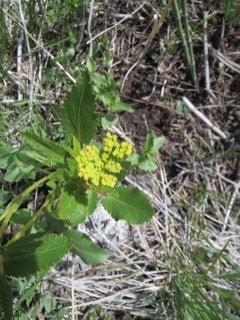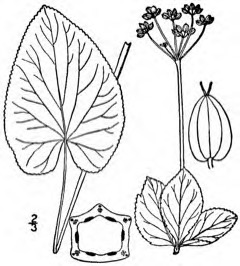 |
|
Chelsea Monks, Black Hills National Forest wikimedia.org |
 |
| botanicalimage.com |
Translate this page:
Summary
Physical Characteristics

 Zizia aptera is an evergreen Perennial growing to 0.6 m (2ft) by 0.6 m (2ft in) at a fast rate.
Zizia aptera is an evergreen Perennial growing to 0.6 m (2ft) by 0.6 m (2ft in) at a fast rate.
See above for USDA hardiness. It is hardy to UK zone 5. The flowers are pollinated by Insects.
It is noted for attracting wildlife.
Suitable for: light (sandy), medium (loamy) and heavy (clay) soils and prefers well-drained soil. Suitable pH: mildly acid, neutral and basic (mildly alkaline) soils and can grow in very alkaline soils.
It can grow in semi-shade (light woodland) or no shade. It prefers dry or moist soil and can tolerate drought.
UK Hardiness Map
US Hardiness Map
Synonyms
Thaspium trifoliatum var. apterum A. Gray. Z. aptera var. aptera
Plant Habitats
Edible Uses
References More on Edible Uses
Medicinal Uses
Plants For A Future can not take any responsibility for any adverse effects from the use of plants. Always seek advice from a professional before using a plant medicinally.
The presence of secondary compounds such as apterin may contribute to the potential medicinal value of Zizia species. Zizia aurea roots have been used by Native Americans as a tea to cure fevers, and the plant has been referred to as a vulnerary (wound-healing) agent [318-1].
References More on Medicinal Uses
The Bookshop: Edible Plant Books
Our Latest books on Perennial Plants For Food Forests and Permaculture Gardens in paperback or digital formats.

Edible Tropical Plants
Food Forest Plants for Hotter Conditions: 250+ Plants For Tropical Food Forests & Permaculture Gardens.
More

Edible Temperate Plants
Plants for Your Food Forest: 500 Plants for Temperate Food Forests & Permaculture Gardens.
More

More Books
PFAF have eight books available in paperback and digital formats. Browse the shop for more information.
Shop Now
Other Uses
Nectary: provides nectar or pollen for beneficial insects [1-2]. The flowers attract butterflies and seed heads attract birds. Various kinds of insects visit the flowers primarily for nectar, especially small bees (Halictid, Andrenid, Nomadine) and flies (Chloropid, Tachinid, Muscid, Syrphid, etc.), as well as occasional beetles and plant bugs. The bees collect pollen as well, while some flies and beetles may feed on pollen. The caterpillars of Papilio polyxenes asterias (Black Swallowtail butterfly) feed on the foliage of this and other members of the Carrot family [1-6]. Suitable for the wild garden and other informal plantings as well as collections of native wild flowers[200]. Cut Flower. Water Purifier: Used in raingarden plantings [318-1].
Special Uses
References More on Other Uses
Cultivation details
An upright short-lived tap-rooted perennial wildflower in the Carrot (Apiaceae) family. Prefers sun or part sun with moist or dry soil. Plants tolerate clay loam, rocky or gravelly soil, alkaline pH and controlled burns. Drought Tolerant. Bloom Time: May to July. Bloom Description: Showy, Yellow. For polyculture design as well as the above-ground architecture (form - tree, shrub etc. and size shown above) information on the habit and root pattern is also useful and given here if available. The plant growth habit is a clumper with limited spread [1-2]. The root pattern is fibrous dividing into a large number of fine roots [1-2].
References Carbon Farming Information and Carbon Sequestration Information
Temperature Converter
Type a value in the Celsius field to convert the value to Fahrenheit:
Fahrenheit:
The PFAF Bookshop
Plants For A Future have a number of books available in paperback and digital form. Book titles include Edible Plants, Edible Perennials, Edible Trees,Edible Shrubs, Woodland Gardening, and Temperate Food Forest Plants. Our new book is Food Forest Plants For Hotter Conditions (Tropical and Sub-Tropical).
Shop Now
Plant Propagation
Seed - we have no information for this species but it is probably best sown in spring in a cold frame. When they are large enough to handle, prick the seedlings out into individual pots and grow them on in the greenhouse for their first winter. Plant them out into their permanent positions in late spring or early summer, after the last expected frosts.
Other Names
If available other names are mentioned here
Meadow zizia, golden alexanders, heart leaved golden alexanders, prairie golden alexanders.
Native Range
NORTHERN AMERICA: Canada (Yukon (southwest), Ontario, Saskatchewan, Alberta, Manitoba, British Columbia), United States (Indiana (southeast), Michigan (Kent Co.), New Jersey, New York, Ohio (south), Pennsylvania, West Virginia, Connecticut, Iowa, Kansas (southeast), Minnesota, Missouri, North Dakota, South Dakota, Illinois (north & southeast), Oklahoma (northeast), Wisconsin, Colorado, Idaho, Montana, Oregon (northwest), Washington (east), Wyoming, Alabama, Arkansas, Delaware, Florida, Georgia, Kentucky, Maryland, North Carolina, South Carolina, Virginia, Mississippi, Tennessee, Nevada (northwest), Utah (north))
Weed Potential
Right plant wrong place. We are currently updating this section.
Please note that a plant may be invasive in one area but may not in your area so it's worth checking.
None Known
Conservation Status
IUCN Red List of Threatened Plants Status : Not Listed.

Growth: S = slow M = medium F = fast. Soil: L = light (sandy) M = medium H = heavy (clay). pH: A = acid N = neutral B = basic (alkaline). Shade: F = full shade S = semi-shade N = no shade. Moisture: D = dry M = Moist We = wet Wa = water.
Now available:
Food Forest Plants for Mediterranean Conditions
350+ Perennial Plants For Mediterranean and Drier Food Forests and Permaculture Gardens.
[Paperback and eBook]
This is the third in Plants For A Future's series of plant guides for food forests tailored to
specific climate zones. Following volumes on temperate and tropical ecosystems, this book focuses
on species suited to Mediterranean conditions—regions with hot, dry summers and cool, wet winters,
often facing the added challenge of climate change.
Read More
Expert comment
Author
(A. Gray) Fernald
Botanical References
Links / References
For a list of references used on this page please go here
Readers comment
| Add a comment |
|
If you have important information about this plant that may help other users please add a comment or link below. Only comments or links that are felt to be directly relevant to a plant will be included. If you think a comment/link or information contained on this page is inaccurate or misleading we would welcome your feedback at [email protected]. If you have questions about a plant please use the Forum on this website as we do not have the resources to answer questions ourselves.
* Please note: the comments by website users are not necessarily those held by PFAF and may give misleading or inaccurate information.
To leave a comment please Register or login here All comments need to be approved so will not appear immediately.
|
|